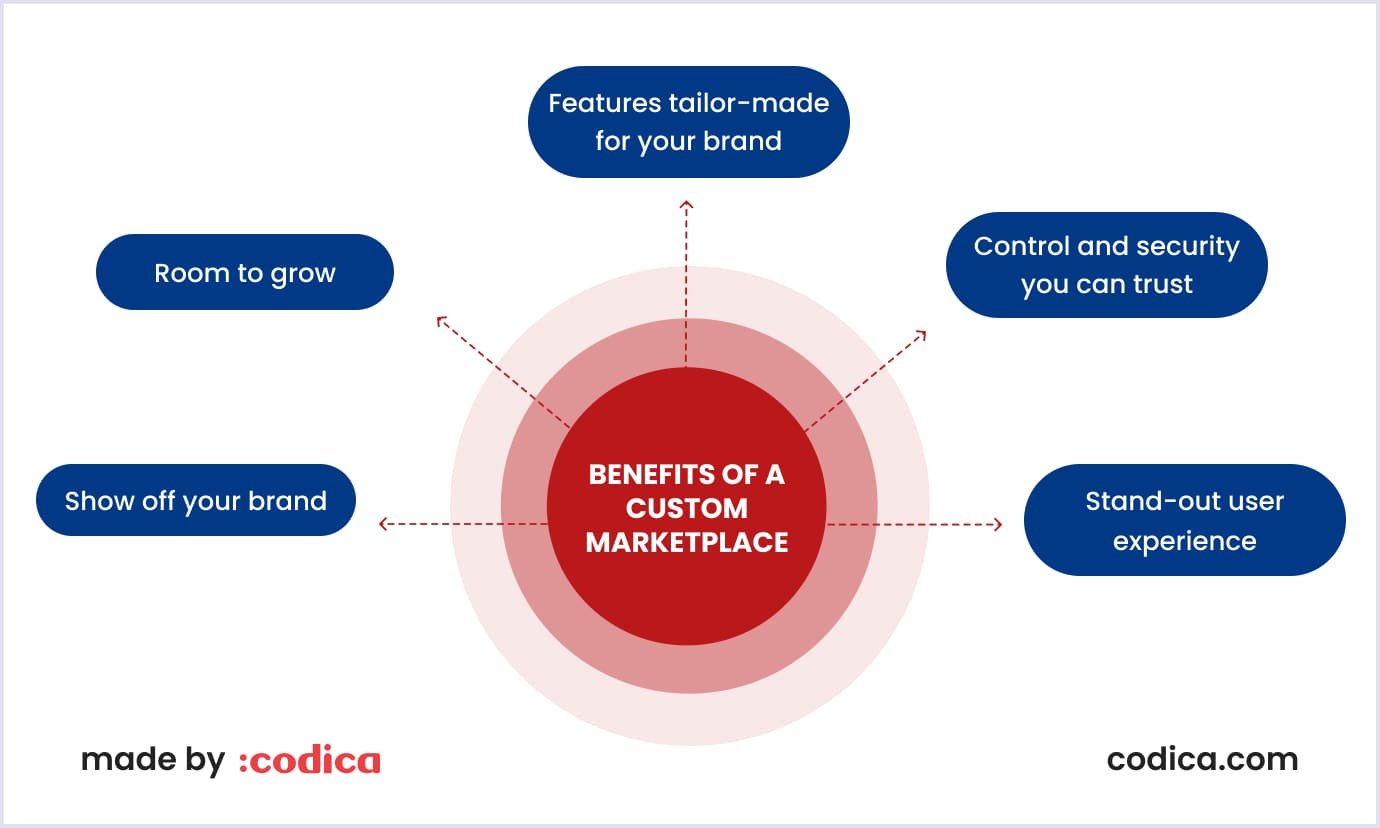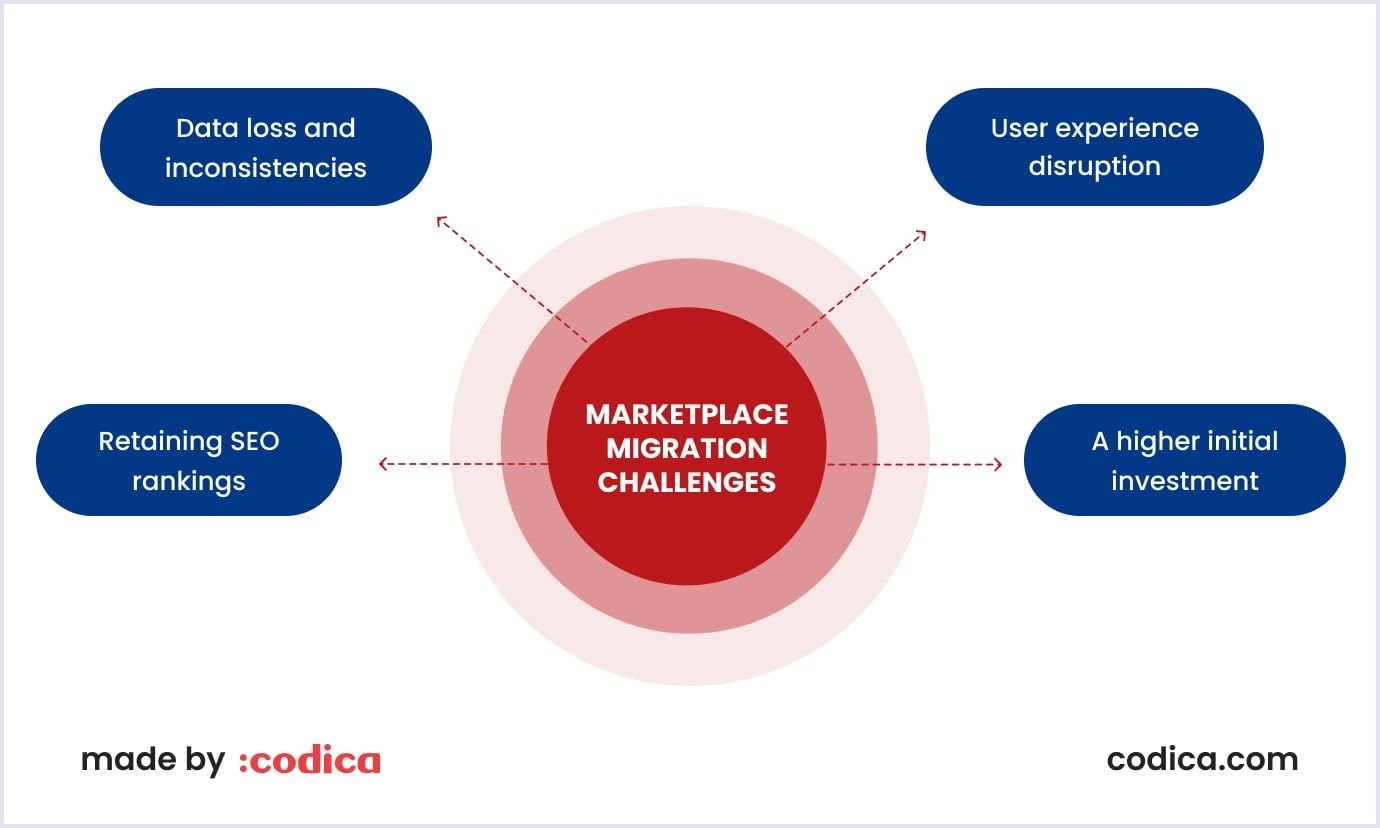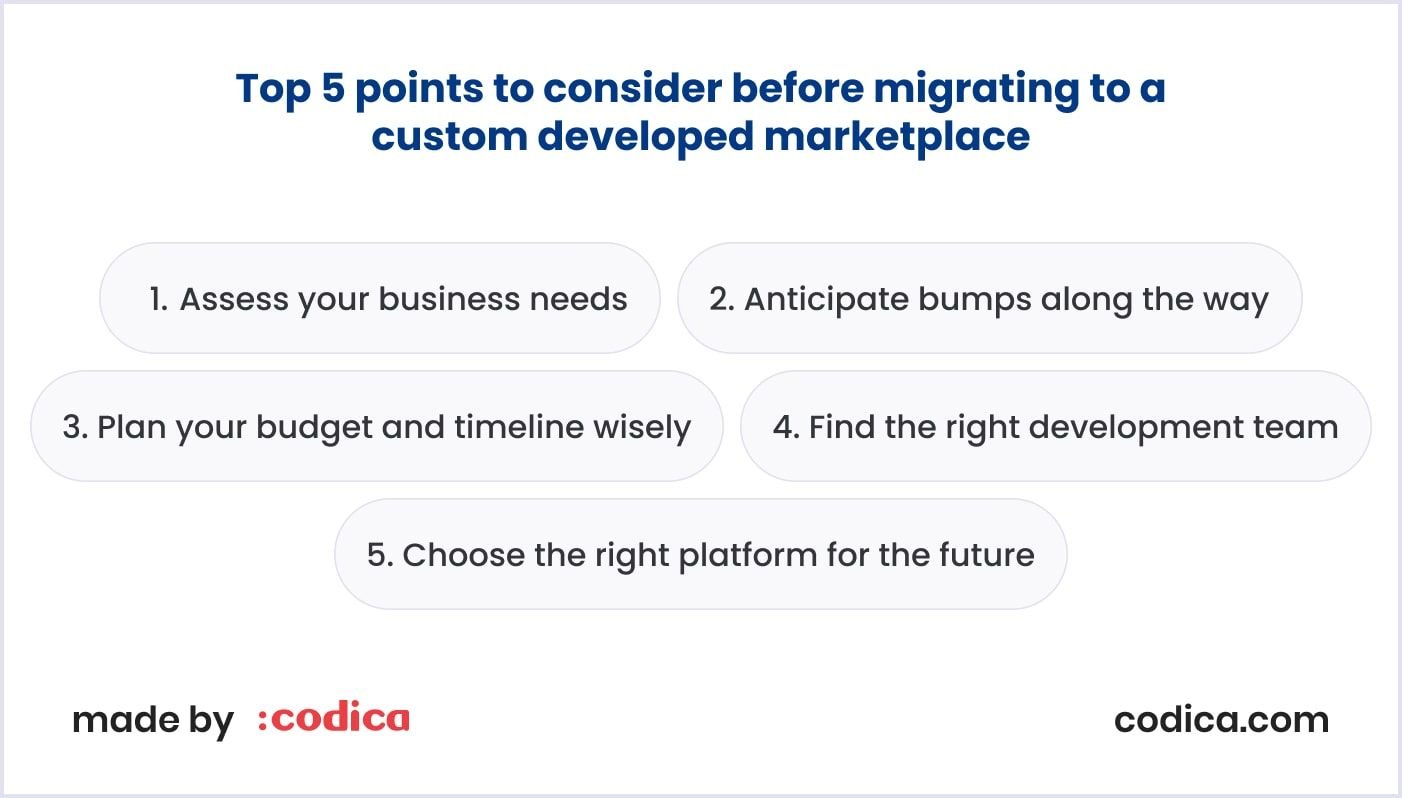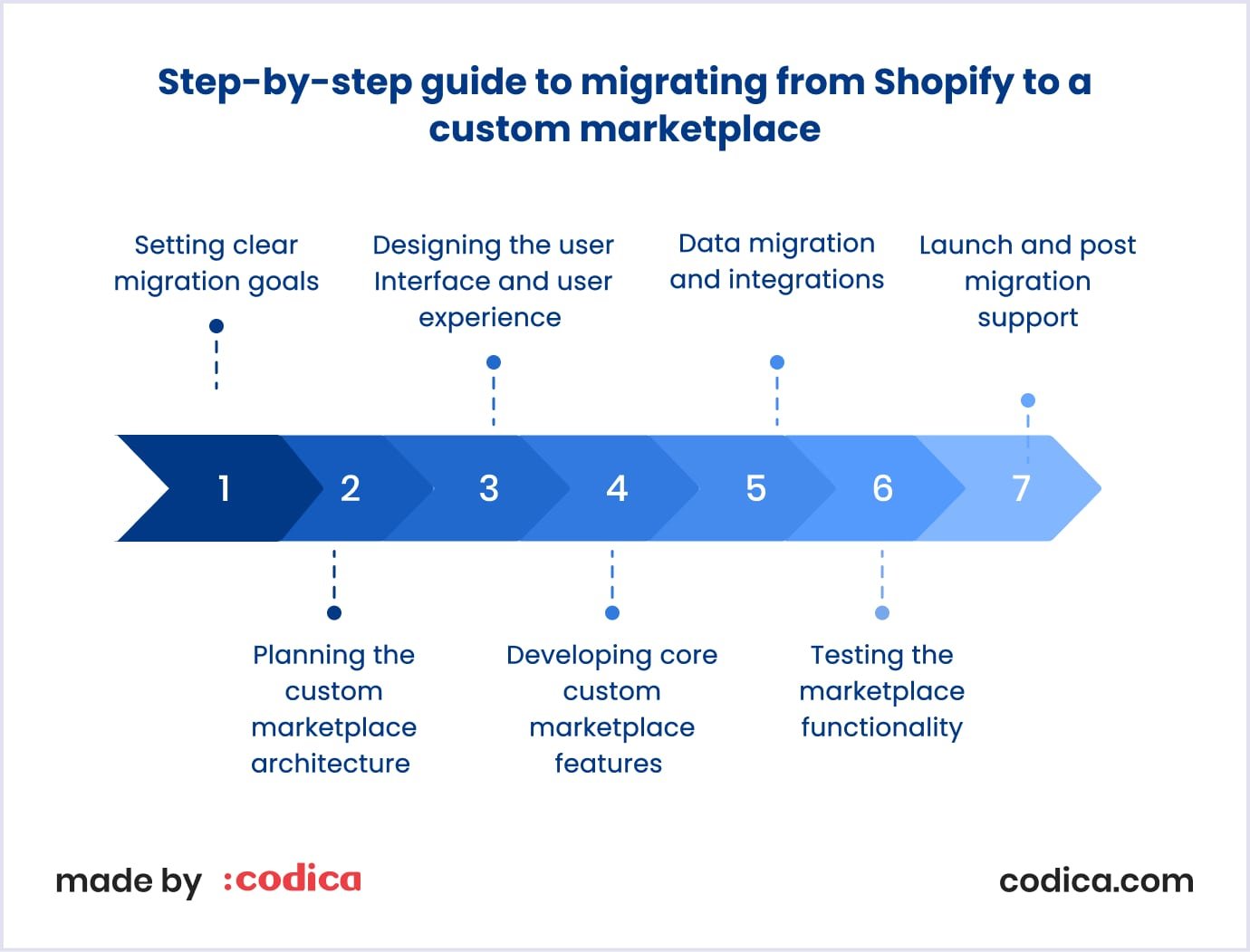The transition from a well-established marketplace such as Shopify or WooCommerce to a custom-built one represents a significant shift. Having built one's business on these user-friendly marketplaces, the prospect of entering an unfamiliar domain can be simultaneously exhilarating and intimidating. The process, however, extends beyond the mere transfer of products: it encompasses the evolution of an entire online presence.
As your business grows, its development may be restricted due to WooCommerce/Shopify limitations. There may be a need for greater flexibility, special features, or a different design that more accurately reflects the brand's identity. In such cases, a custom marketplace can be a valuable solution. It allows businesses to have a space built specifically for them, enabling them to create a shopping experience that aligns with their vision, and not only.
In this article, we’ll present a step-by-step guide to migrating from Shopify or WooCommerce to a custom marketplace. We are going to outline the potential benefits, address common challenges, and provide guidance on how to migrate from Shopify or WooCommerce to a custom marketplace in a smooth and efficient manner. Whether the prospect excites or intimidates, the objective is to provide support and guidance as businesses embark on this new and promising venture.
Benefits and challenges of migrating to a custom marketplace
Those who invest in custom ecommerce development are more likely to profit significantly from such a move. Did you know that businesses with custom solutions report up to 30% higher customer retention rates? Ideally, a marketplace will align with your concept and direction while also fostering stronger relationships with your audience.
Reasons why a custom-developed marketplace could be your best move

Choosing a marketplace that is custom is not just a question of functionality. It’s building a space that resonates with your users and reflects your unique vision. Here are the custom marketplace benefits and an explanation of why investing in it can be one of the most impactful decisions for your business.
- Features tailor-made for your brand. Evidently, imagine having a marketplace that does just what you want. In custom development, one may create features to deal with the needs of their audience and make their experience smooth and enjoyable;
- Room to grow. Your business is unique and will evolve with time. Thus, it will be able to grow and adapt to a custom marketplace. Whether you want to add new features or take in more users, you will not be limited by the disadvantages of pre-made solutions;
- Show off your brand. Your marketplace should be a reflection of you as a brand. With custom marketplace development, every part of the design is in your hands to ensure it turns out just the way you had it in mind for building a loyal community with the same sense as your brand identity;
- Control and security you can trust. You have full control over security and data management when you build your own marketplace. You can implement security measures that are tailor-made to protect the users and keep information safe for one and all with peace of mind;
- Stand-out user experience. With a marketplace customized to suit your needs, you can truly focus on the user journey and make it as intuitive and enjoyable as possible. You meet the needs and preferences of your users, and they will engage more and also return more often, which drives your success.
Common challenges in migrating to a custom marketplace

While the migration of a marketplace is a promising endeavor, it’s not without its inherent challenges. Here is a brief overview of the common WooCommerce/Shopify migration challenges that may be encountered during the migration process. Below,we discuss how a custom route may still prove to be the superior option:
- Data loss and inconsistencies. The potential loss during WooCommerce or Shopify data migration is a significant concern. In contrast, a custom marketplace offers more manageable data transfer or processes, reducing the risk of data loss and ensuring data integrity for a more reliable platform;
- Retaining SEO rankings. The migration process can result in the disruption of search engine optimization (SEO) rankings, which can negatively impact a business's visibility and traffic. However, a custom solution allows businesses to establish SEO best practices from the outset, ensuring that search rankings are maintained and potentially enhanced;
- User experience disruption. User experience disruption can be paradoxical, as transitioning to a new platform may confuse users. Factors like unfamiliar navigation, a learning curve, data migration issues, and technical glitches contribute to this confusion. However, this shouldn't be a major concern, as custom marketplace development can create an intuitive user experience tailored to the target audience. While the initial transition may present challenges, the long-term benefits make it a worthwhile investment;
- A higher initial investment. The financial outlay required for custom marketplace development is significantly greater than that needed for off-the-shelf marketplace solutions. This is a concern for many businesses. However, it is important to consider the long-term benefits of investing in a custom marketplace, which can enhance business efficiency in the future. For more insights on budgeting for your project, check out our guide on ecommerce website cost.

Codica’s fortunate migration experience
Our company helped the Detroit Ammo Co. marketplace by migrating to a custom solution. During the build of this custom ecommerce site for online firearm sales, the primary challenges that we resolved were as follows:
- Increased site speed. The custom ecommerce marketplace performance of the site improved significantly, resulting in a notable increase in speed for users;
- Faster feature additions. The process of incorporating new features has been expedited, and the implementation of these features is now more streamlined and efficient, without the reliance on temporary fixes;
- A "friendly platform". The platform is designed with the end user in mind to provide clarity and helpfulness in the marketplace context. This approach is intended to enhance user satisfaction and facilitate more effective decision-making;
- Improved search functionality. We improved the search capabilities using Elasticsearch, resulting in much faster and straightforward searches. Now, users can easily find the information they need, making their shopping experience smoother than ever;
- Ownership by client. The client is the proprietor of the platform, code, and all related assets, thereby conferring greater autonomy and flexibility.
This migration proved to be a solution to a number of critical issues, while simultaneously establishing a robust foundation for future growth and innovation.
Thoughtful points to look out for before migrating to a custom ecommerce marketplace
The migration from Shopify and WooCommerce to a custom-developed marketplace represents a significant transition. To approach this change in a considered manner, here are five key considerations you need to pay attention to:

1. Assess your business needs
It is recommended that you take some time to reflect on your current operational procedures. Which functionalities do you consider to be essential for your growth yet are not offered by your current platform? It would be beneficial to reflect on your product range, customer experience, and the tools that you utilize in your operations. The creation of a list of your requirements will ensure that the new marketplace is fully aligned with your needs.
2. Anticipate bumps along the way
It’s inevitable that every migration will encounter difficulties. These may include data loss, downtime, and compatibility issues. It is, therefore, essential to be aware of the potential challenges that may arise in advance in order to develop an appropriate plan to overcome them. In addition, it is important to assess the technical expertise of the team, as having the right support in place is crucial to success.
3. Plan your budget and timeline wisely
It’s now necessary to establish a realistic budget and timeline for a seamless data migration from Shopify. This is typically more expensive than ready-made solutions. Therefore, it is essential to consider all costs, including design, development, hosting, and ongoing maintenance. It is advisable to create a timeline that allows sufficient time for thorough testing and for implementing changes to ensure a smooth transition for customers.
4. Find the right development team
It is advisable to select a development team that has a proven track record in custom marketplace development projects. Additionally, a review of the team's portfolio and client feedback can facilitate an informed decision. Make sure you are comfortable working with them. In case of any doubts or concerns, it is recommended to explore the available options for online marketplace development services to identify the most suitable expertise.
5. Choose the right platform for the future
Not all migrating ecommerce platforms are created equal, and careful selection is essential. In selecting an ecommerce platform, it is of paramount importance to consider the platform's scalability, security, and ease of use. Consider options like Spree Commerce, Vendure, or Saleor. These platforms offer modularity and can handle increased traffic, making them ideal for growing businesses.
Incorporating these factors into the decision-making process will facilitate a more optimal migration process and contribute to the success of a custom-developed marketplace.

Step-by-step guide to migrating from Shopify to a custom marketplace
Shopify to a custom platform migration may sound daunting, but it can also be a great opportunity to reshape your online presence if approached thoughtfully. Here is our guide to help you through the process in a fresh and engaging way.

Step 1: Setting clear migration goals
Before all the technical intricacies, let's outline clear goals and think about what you want.
- Uncover hidden opportunities. Determine what sets your business apart and consider new features or services you wish to implement;
- Conduct market research. Analyze competitors and industry trends to inform your migration strategy and identify potential enhancements;
- Consult with stakeholders. Involve team members and other stakeholders in discussions. Their insights can provide valuable perspectives and ensure that everyone's needs are addressed in the planning process.
Step 2: Planning the custom marketplace architecture
Allow yourself to be more creative with the custom marketplace architecture.
- Tech stack. Сhoose the tech stack that ensures a dynamic and scalable user experience. For example, by using modern frameworks such as Next.js in the frontend and Node.js in the backend;
- Database. Select the database structure that will include organized tables for users, products, categories, orders, reviews, and wishlists efficient in the management and retrieval of data;
- Framework selection. After establishing a tech stack, choose a suitable framework for development. This decision will influence everything from user experience to performance;
- Headless platform. Headless platform means more freedom in front-end development. It also allows more personalized experiences for the many different audiences and speeds up adaptation when business needs change;
- Future-proofing. Think about your business in 5 years' time. Design your custom marketplace architecture in such a way that it will integrate seamlessly with emerging trends and technologies, such as AI or VR. We recommend using MACH architecture with adjustable services to ensure your solution is flexible and scalable.
All these may blend together to amplify the success of your project. Interested in more? Feel free to take a deeper look at our product discovery services by reading how we can help that vision for your marketplace take flight.
Recommended reading: What Is Project Discovery Phase in Custom Software Development
Step 3: Designing the user experience and user interface
Marketplace design isn't just about making it pretty. A seamless user experience is crucial for customer retention and overall happiness. Thus, consider the following in your UI/UX design services:
- Storytelling through design. Consider how your design will tell your brand story. Colors, typography, and images should all resonate with your audience;
- Empathy mapping. Understand your product and analyze the target audience. Consider user needs and problems faced. As a result of this work, you will be able to create an ideation of your marketplace's design;
- Quality UX development. Have a high focus on high-quality UX design through user testing and iterating upon improvements based on the feedback. A good user experience will tend to increase the rates of customer loyalty as well as conversion rates very significantly;
- Interactive prototyping. Create interactive prototypes. Allow potential users to actually interact with your design and allow real-time feedback.
Step 4: Developing core custom marketplace features
Time to implement the crucial custom marketplace features that will drive your marketplace's functionality.
- Product management tools. Integrate product listing, categorization, and inventory management tools for smooth functioning;
- User accounts and profile system. Introduce user account functionality securely, considering registration, login, and account management;
- Shopping cart and checkout process. Implement an intuitive workflow of shopping cart check-out to minimize abandonment rates;
- API integrations. Payment processing, shipping integrations, inventory management or marketing automation integrations. Create required APIs to facilitate payment processing, shipping, and other third-party services.
Start with MVP development services and add more features based on user feedback.
Step 5: Data migration and integrations
The key to a smooth transition is migrating your data with caution.
- Data mapping. Find out how your Shopify existing data-products, customers, orders will be mapped onto the new system;
- Data backup. Create backups for all your current data, before starting the migration process, so that you won't face any loss thereof;
Step 6: Testing the marketplace functionality
Quality assurance services will ensure that things are oiled right and you are well on your way to release.
- Functional testing. Ensure that all features are placed in functioning order, starting from the user registration down to payment processing;
- Performance testing. To make sure the site is working in different conditions and under the load expected;
- User acceptance testing. Real users test the marketplace and give comments on how 'easy to use' it is.
At Codica, we use test-driven development and automated testing to ensure solutions work correctly before deployment.
Step 7: Launch and post-migration support
Once testing is complete, it's time to go live with your custom marketplace.
- Plan your launch. Develop a marketing strategy around your launch in order to attract users to the new platform;
- Monitor performance. Tracking performance in the marketplace, elicit user feedback upon launch;
- Commit to continuous improvement. Be ready for active changes based on ongoing user interactions and emerging requirements.
The following steps will guide you smoothly through the transition from Shopify into a custom marketplace that truly serves you and your customers better.

Conclusion
Indeed, migration from a Shopify or WooCommerce-powered marketplace can have a profound impact on a business. Rather than relying on a platform that may not align with one's vision and needs, a custom solution allows the creation of a platform that is tailored to the specific requirements of the business, resulting in happier customers and a more seamless user experience. The ability to add unique features and integrations is greatly enhanced with a custom solution, providing a significant competitive advantage in adapting to market changes.
Our company has extensive experience in the design of bespoke marketplaces, as evidenced by our online firearms sales platform case study. This demonstrates our ability to address unique challenges, enhance customer engagement, and ensure compliance. It is also important to note that a custom-made platform will offer higher performance and security, which will contribute to a sense of peace of mind. Ultimately, investing in custom development will have a greater impact than simply renewing technology. It represents a strategic move toward long-term growth and success.
This is why we are pleased to assist with innovation. Share your needs with us, and we'll craft the perfect software for your organization. Check out our portfolio for more our work examples.
